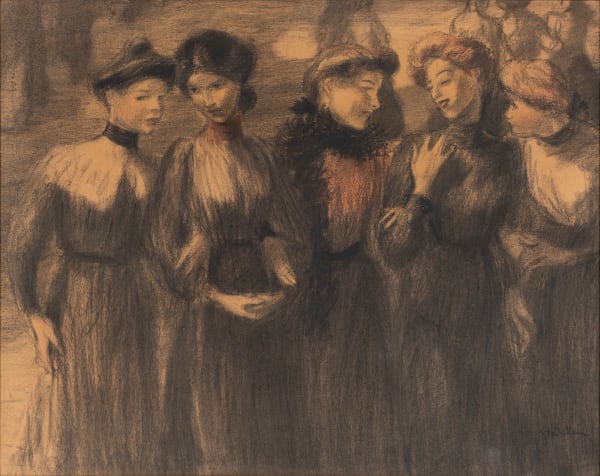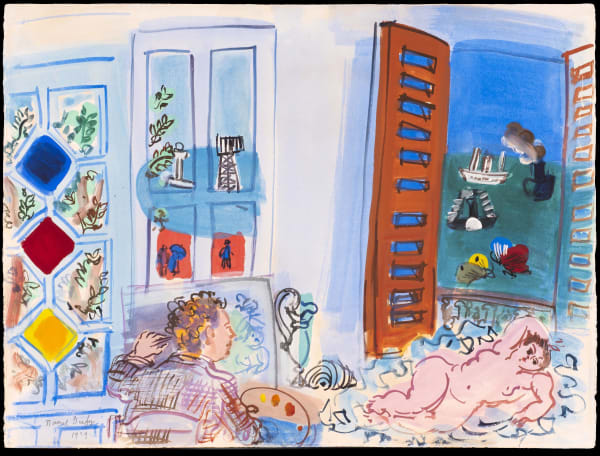-
Introduction
This exhibition delves into the extraordinary trajectory of Modernism in the late nineteenth and early twentieth centuries. The Impressionists found a new method of painting traditional subjects, the Pointillists explored colour theory and the Cubists redefined the concept of form. This was an remarkable period for art in which change was embraced and the long accepted canon challenged with an inquisitive spirit.
-
-

Renoir painting at the Villa de la Poste, Cagnes, 1903
-
Instead of working from preliminary sketches the artists painted what was before them in that moment. This was made possible by John Rand’s 1841 invention of the aluminium paint tube that is still used to this day. It allowed for paint to be easily transported and keep its longevity. While their predecessors had taken great pains to mix colours, the Impressionists used pure colour straight from the tube. Renoir once exclaimed how “Without colours in tubes, there would be no Cézanne, no Monet, no Sisley or Pissarro: nothing of what the journalists were later to call Impressionism”.
-
Available Works
-

Edgar Degas Chez la modiste (modiste garnissant un chapeau), c.1885,
Pastel and charcoal on paper, 46 x 58.8 cm
-
With the new emphasis on observation, artists such as Toulouse-Lautrec, Degas and Caillebotte fig2. took to recording those on the fringes of popular society with dignity and honesty. The Realist artists Courbet, Manet fig1. and Corot – who preceded Toulouse-Lautrec and Degas - had depicted the realities working class life, from afar with a detachment from their subjects. Degas and Toulouse-Lautrec thrust the viewer into the scene.
-
The feminist ideal of the New Woman also emerged, propelled by the rise in education and job opportunities for women. Of particular importance was the department store, which was a unique space that allowed women to mingle in society unchaperoned. Previously women had largely been employed at the factory or home, but the role of the saleswomen gave women a new opportunity within society.
-
Available Works
-

Camille Pissarro
-
Camille Pissarro : Pointillist Works
-
Available Works
-
-
Available Works
-
 Marc Chagall, Corbeille au soleil (Gordes), c.1938-9Gouache, watercolour and pencil on paper, 60.5 x 48.6 cm
Marc Chagall, Corbeille au soleil (Gordes), c.1938-9Gouache, watercolour and pencil on paper, 60.5 x 48.6 cm -
The period after World War I also saw artists seek a way of dealing with trauma. While the Expressionist looked to visualising the horrors of their experience, other artists sought a new lightness and joy in their work. Painters such as Dufy and Chagall desired an escapism from reality, producing works that transgressed stereotypical figuration.
-
Available Works
-
 Andre Lhote, Les Footballeurs, 1916, Oil on canvas, 64 x 80 cm
Andre Lhote, Les Footballeurs, 1916, Oil on canvas, 64 x 80 cm -
While Futurism, Vorticism and Dada all embraced sport as an opportunity to express physicality and movement, for the cubists it was of particular interest. Jean Metzinger painted cyclists, Robert Delaunay depicted depicted runners, while between 1916 and 1920 Andre Lhote created his extraordinary rugby paintings. The sport had been introduced to France from England in the early 1870s and represented the ultimate in physical power.
-
-

Jean Metzinger, Au Vélodrome, 1911-1912, Oil on canvas, 130.4 cm × 97.1 cm, Peggy Guggenheim Collection, Venice
-

Robert Delaunay, L'Équipe de Cardiff, 1913, Oil on canvas, 326 x 208cm, Musée d'Art Moderne de la ville, Paris
-

Albert Gleizes, Les Joueurs de football, 1912-13, Oil on canvas, 225.4 x 183cm, National Gallery of Art, Washington D.C.
-
-
Sport allowed the artists to express the energy, dynamism, excitement, and speed of the games as well as their aggression. The sharp geometric forms with figures cutting across each other was the perfect subject for the cubists to explore various depths and multiple planes of vision.
-
Available Works
-













































